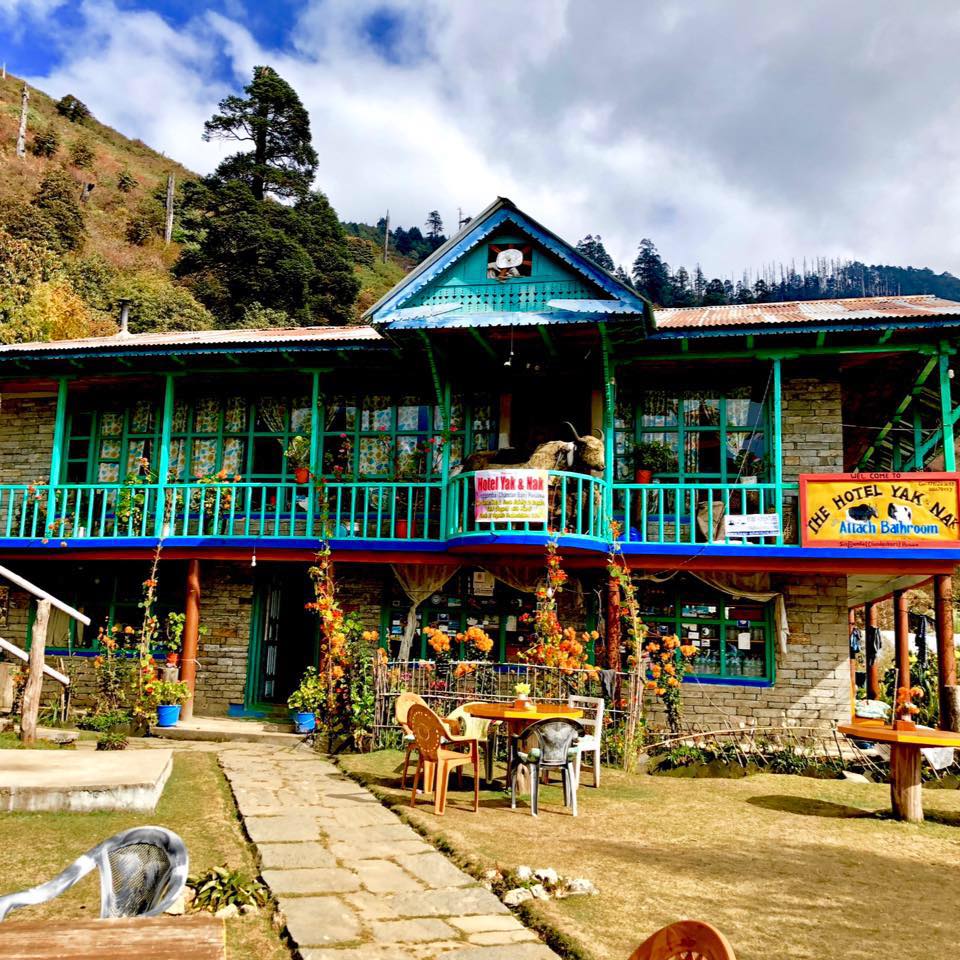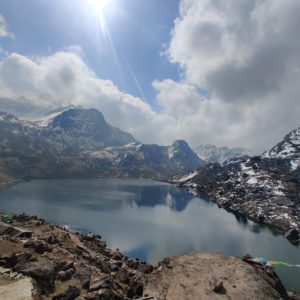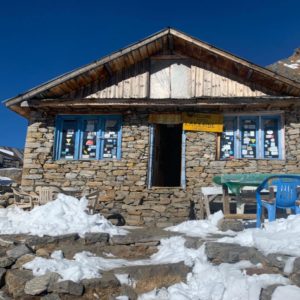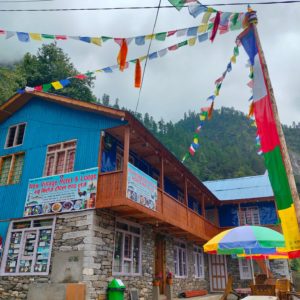
Taking a steaming cup of tea in my hands, I stepped out onto the Palmo’s teahouse porch. And there it was, a rainbow stretching across the vast expanse of the Langtang mountain range. The vibrant colors contrasted against the backdrop of the rugged terrain. I stood there, in awe but also a profound sense of peace.
At 30, I have completed multiple treks in Nepal. This isn’t a flex to my physical prowess. Because trekking in Nepal is made more accessible and relaxing with a phenomena called the ‘teahouse treks’. While the technical definition of trekking is to go on an arduous journey on foot, teahouse treks in Nepal makes the journey almost restful and certainly, memorable.
Along popular trekking routes in Nepal, one can find a network of teahouses, hence the name, which are small lodges or guest houses specifically catering to trekkers. They offer a level of convenience that is not often found in other trekking destinations across the globe. These Nepali teahouses provide in addition to deliciously warm teas, basic accommodation, meals, and facilities, making it much easier for trekkers to focus on the journey without worrying about camping equipment or carrying heavy loads of food. It is an integral part of the journey through the Himalayas, promising comforting respite along the way.
The Teahouse Trek is an antidote to destination obsession. It’s an unhurried climb where you stop at intervals. The teahouse owners have created their own microcosm in the middle of nowhere and you get to have an experience too of their life.
“It isn’t an easy life, but it’s the life we’ve chosen. When our guests reach the destination, it’s joyous for us. We want to help them in any way we can. If we don’t help them, who will? And every guest adds something to our life” shares Palmo Lama, a teahouse owner along the trails of Gosaikunda lake.
But these teahouses are more than just rest stops. In need, they turn into a hub of valuable information and connection that will enrich the entire trekking experience.
“When I reached a fever of 102 on my solo trek, the teahouse owners treated me like I was their own,” shares Anusha, an occasional trekker from Kathmandu, reminiscing about her very first solo trek to the vastly unexplored and rugged trekking route of Dolpo in Nepal. The teahouse owners are still one of the fondest memories she holds. With exceptions to certain mountain climbing treks, most trekking routes in Nepal have warm tea houses spread along the way, that make the trek a little easier, more approachable and a lot safer.
Recently, I embarked on a trek to Gosaikunda, an alpine freshwater oligotrophic lake within Langtang National Park. It was my second time. I had to quit my very first try in the beginning of March 2022 for myriad reasons including awful weather, an ill-timed work emergency and a quickly settling affliction of the body. My partner and I had stopped at Khendi, the third stop on the nine-stop trek. We were going to return home soaked, defeated, tired, and with tons of work waiting. We were heartbroken with the realization that we were really giving up.
“What’s the use of getting to where you are, if you can’t enjoy it,” came the gentle and wise words of our teahouse host, Palmo Lama of New Village Hotel and Lodge,.
“Call us for weather updates and we’ll have a room for you,” she promised when we said our goodbyes.
And call her, we did. For months, we took updates from Palmo about the roadway, the weather, the trekking trail conditions and she answered them all patiently. When finally, a few months after the first attempt, we reached Khendi again, Palmo greeted us with a warm smile.
She became our unofficial weather forecaster. With her deep understanding of the region, she shared what the sky looked like within the national park. We planned our treks accordingly. Her wisdom was invaluable, ensuring we were well-prepared.
Additionally, Palmo and her partner Singi Lama recommended other tea houses along the way. They helped us get in touch with their owners offering us the opportunity to time our meals strategically.

The aroma of sweet tea wafts through the air, that weary trekkers like us respond eagerly to. Over the years, I have taken to stopping by the teahouses on my treks, even if for a brief pause. It adds a little extra to my journey. By the fireplace, trekkers gather, share progress and experiences, something those who have never responded to the call of the mountains would not understand. At Deurali, fourth stop on the Gosaikunda trek, I met trekkers on their way back from the destination. They couldn’t stop gushing about my destination, and about taking a dip at the lake at 4380 m. When I reached Gosaikunda lake, I remembered their excitement, and heard Palmo’s voice as I overcame the shock of the freezing water over the shouts of cheer and love from other trekkers waiting in line to do the same.
Photos by Ritu Rajbanshi of teahouses on her trek to Gosaikunda Lake
When You Go
To plan your Teahouse Trek in Nepal, your starting point is Kathmandu. We offer some options for stay and things to do here before embarking on your trek.
How to get there: The nearest airport to Kathmandu is the Tribhuvan International Airport (KTM). To start a teahouse trek, you’ll need to reach the specific trailhead or location where the trek begins. Most popular teahouse treks start from Lukla (for Everest region treks), Pokhara (for Annapurna region treks), or Jomsom (for Mustang region treks). Domestic flights from Kathmandu to Lukla, Pokhara, or Jomsom from Kathmandu are an option, with flight durations around 20-30 minutes.
Where to stay in Kathmandu: Kathmandu offers a wide range of accommodation options to suit various budgets.
Luxury hotels: Dwarika’s Hotel, Hyatt Regency Kathmandu, Hotel Yak & Yeti
Mid-range hotels: Kathmandu Marriott Hotel, Hotel Shanker, Hotel Vaishali
Budget options: Thamel area has many guesthouses and budget hotels
Where to eat in Kathmandu: Kathmandu has a diverse culinary scene with restaurants serving various cuisines. Some popular restaurants include Krishnarpan (traditional Nepali cuisine), Thamel House Restaurant (authentic Newari cuisine), Bhojan Griha (Nepali cultural and dining experience), Fire and Ice Pizzeria, OR2K (vegetarian and Middle Eastern)
Where to shop for tea: Everest Tea Garden and The Tea Studio, both in Thamel
Best time to visit: The primary trekking seasons in Nepal are spring (March to May) and autumn (September to November) when the weather is most favorable and the skies are generally clear. Trekking during seasons also means all the tea houses along the routes are open. The teahouse owners usually migrate to lower regions during off-seasons for safety and economic reasons.
Before you go: Although no vaccination is legally required to enter Nepal. I’d still recommend you consult with a travel agent/ doctor to ensure you have the necessary vaccinations and are fit for trekking at high altitudes.
Local Information: Detailed information on treks and current conditions of trekking trails are available with the Nepal Tourism Board or the Trekking Agencies’ Association of Nepal (TAAN).
Choosing your trek: Treks in Nepal are divided as Easy, Moderate and Advanced. While the former two are teahouse treks, availability of teahouses are not guaranteed for advanced treks. Popular easy treks are the Ghorepani Poon Hill Trek and Langtang Valley Trek while The Everest Base Camp Trek and Annapurna Base Camp Trek fall into the moderate category. Experienced trekkers seeking challenging routes can try the Manaslu Circuit Trek and Upper Mustang Trek. However, do remember that even “easy” treks may involve some level of physical fitness and acclimatization to the altitude.
Planning the teahouse route: Research the first teahouse on your route. The frequency of teahouses depends on the trekking region. In well-trodden areas, teahouses are relatively close together, and you can find one every few hours. One usually knows the others so snowballing information is easy. In more remote regions or advanced trekking routes, the distance between teahouses may be longer and scarce. So getting in contact (usually through personal research or through your guide) is a good way to stay prepared.
What to expect from a teahouse: Teahouse menus typically offer a variety of dishes, including local Nepali food (dal bhat – rice, lentils, and vegetables), international cuisine (pasta, noodles, etc.), and snacks (pancakes, eggs, etc.). The availability of food depends on the remoteness of the teahouse. During the peak trekking seasons, teahouses rarely close, but in the offseason, some may shut down due to low tourist numbers.
It is also recommended to seek information regarding teahouses on your trek from guidebooks, online travel forums or Nepal Tourism Board assigned local guides (revised Trekkers Information Management System Provision effective from March 31, 2023, require specific Protected Areas of Nepal for trekkers to be accompanied by licensed trekking guide and carry a trekking agency issued TIMS Card).
Tea Market
Get More Value from Your Tea: BRU Maker One
+41794574278
Jacque's Organics
(647) 804-7263

